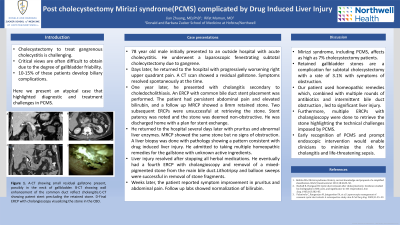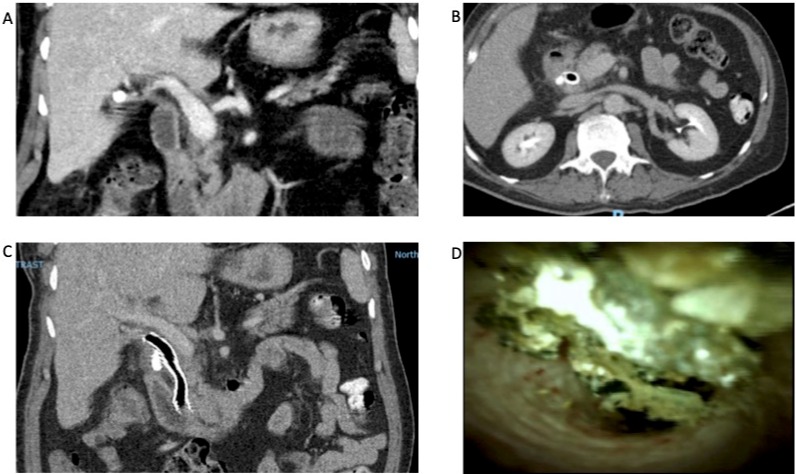Sunday Poster Session
Category: Biliary/Pancreas
P0079 - Post Cholecystectomy Mirizzi Syndrome (PCMS) Complicated by Drug Induced Liver Injury
Sunday, October 22, 2023
3:30 PM - 7:00 PM PT
Location: Exhibit Hall

Has Audio
- JZ
Jian Zhuang, MD, PhD
Northwell Health
Manhasset, NY
Presenting Author(s)
Jian Zhuang, MD, PhD1, Rifat Mamun, MD2
1Northwell Health, Manhasset, NY; 2Northwell Health, Great Neck, NY
Introduction: Cholecystectomy to treat gangrenous cholecystitis is challenging. Critical views are often difficult to obtain due to the degree of gallbladder friability. 10-15% of these patients develop biliary complications. Here we present an atypical case that highlighted diagnostic and treatment challenges in PCMS.
Case Description/Methods: 78 year old male initially presented to an outside hospital with acute cholecystitis. He underwent a laparoscopic fenestrating subtotal cholecystectomy due to gangrene. Days later, he returned to the hospital with progressively worsening right upper quadrant pain. A CT scan showed a residual gallstone. Symptoms resolved spontaneously at the time. One year later, he presented with cholangitis secondary to choledocholithiasis. An ERCP with common bile duct stent placement was performed. The patient had persistent abdominal pain and elevated bilirubin, and a follow up MRCP showed a 8mm retained stone. Two subsequent ERCPs were unsuccessful at retrieving the stone. Stent patency was noted and the stone was deemed non-obstructive. He was discharged home with a plan for stent exchange. He returned to the hospital several days later with pruritus and abnormal liver enzymes. MRCP showed the same stone but no signs of obstruction. A liver biopsy was done with pathology showing a pattern consistent with drug induced liver injury. He admitted to taking multiple homeopathic remedies for the gallstone with unknown active ingredients. Liver injury resolved after stopping all herbal medications. He eventually had a fourth ERCP with cholangioscopy and removal of a mixed-pigmented stone from the main bile duct.Lithotripsy and balloon sweeps were successful in removal of stone fragments. Weeks later, the patient reported symptom improvement in pruritus and abdominal pain. Follow up labs showed normalization of bilirubin.
Discussion: Mirizzi syndrome, including PCMS, affects as high as 7% cholecystectomy patients.Retained gallbladder stones are a complication for subtotal cholecystectomy with a rate of 3.1% with symptoms of obstruction. Our patient used homeopathic remedies which, combined with multiple rounds of antibiotics and intermittent bile duct obstruction , led to significant liver injury. Furthermore, multiple ERCPs with cholangioscopy were done to retrieve the stone highlighting the technical challenges imposed by PCMS. Early recognition of PCMS and prompt endoscopic intervention would enable clinicians to minimize the risk for cholangitis and life-threatening sepsis.

Disclosures:
Jian Zhuang, MD, PhD1, Rifat Mamun, MD2. P0079 - Post Cholecystectomy Mirizzi Syndrome (PCMS) Complicated by Drug Induced Liver Injury, ACG 2023 Annual Scientific Meeting Abstracts. Vancouver, BC, Canada: American College of Gastroenterology.
1Northwell Health, Manhasset, NY; 2Northwell Health, Great Neck, NY
Introduction: Cholecystectomy to treat gangrenous cholecystitis is challenging. Critical views are often difficult to obtain due to the degree of gallbladder friability. 10-15% of these patients develop biliary complications. Here we present an atypical case that highlighted diagnostic and treatment challenges in PCMS.
Case Description/Methods: 78 year old male initially presented to an outside hospital with acute cholecystitis. He underwent a laparoscopic fenestrating subtotal cholecystectomy due to gangrene. Days later, he returned to the hospital with progressively worsening right upper quadrant pain. A CT scan showed a residual gallstone. Symptoms resolved spontaneously at the time. One year later, he presented with cholangitis secondary to choledocholithiasis. An ERCP with common bile duct stent placement was performed. The patient had persistent abdominal pain and elevated bilirubin, and a follow up MRCP showed a 8mm retained stone. Two subsequent ERCPs were unsuccessful at retrieving the stone. Stent patency was noted and the stone was deemed non-obstructive. He was discharged home with a plan for stent exchange. He returned to the hospital several days later with pruritus and abnormal liver enzymes. MRCP showed the same stone but no signs of obstruction. A liver biopsy was done with pathology showing a pattern consistent with drug induced liver injury. He admitted to taking multiple homeopathic remedies for the gallstone with unknown active ingredients. Liver injury resolved after stopping all herbal medications. He eventually had a fourth ERCP with cholangioscopy and removal of a mixed-pigmented stone from the main bile duct.Lithotripsy and balloon sweeps were successful in removal of stone fragments. Weeks later, the patient reported symptom improvement in pruritus and abdominal pain. Follow up labs showed normalization of bilirubin.
Discussion: Mirizzi syndrome, including PCMS, affects as high as 7% cholecystectomy patients.Retained gallbladder stones are a complication for subtotal cholecystectomy with a rate of 3.1% with symptoms of obstruction. Our patient used homeopathic remedies which, combined with multiple rounds of antibiotics and intermittent bile duct obstruction , led to significant liver injury. Furthermore, multiple ERCPs with cholangioscopy were done to retrieve the stone highlighting the technical challenges imposed by PCMS. Early recognition of PCMS and prompt endoscopic intervention would enable clinicians to minimize the risk for cholangitis and life-threatening sepsis.

Figure: A-CT showing small residual gallstone present, possibly in the neck of gallbladder. B-CT showing wall enhancement of the common duct reflect cholangitis.C-CT showing patent stent precluding the retained stone. D-Final ERCP with cholangioscopy visualizing the stone in the CBD.
Disclosures:
Jian Zhuang indicated no relevant financial relationships.
Rifat Mamun indicated no relevant financial relationships.
Jian Zhuang, MD, PhD1, Rifat Mamun, MD2. P0079 - Post Cholecystectomy Mirizzi Syndrome (PCMS) Complicated by Drug Induced Liver Injury, ACG 2023 Annual Scientific Meeting Abstracts. Vancouver, BC, Canada: American College of Gastroenterology.
